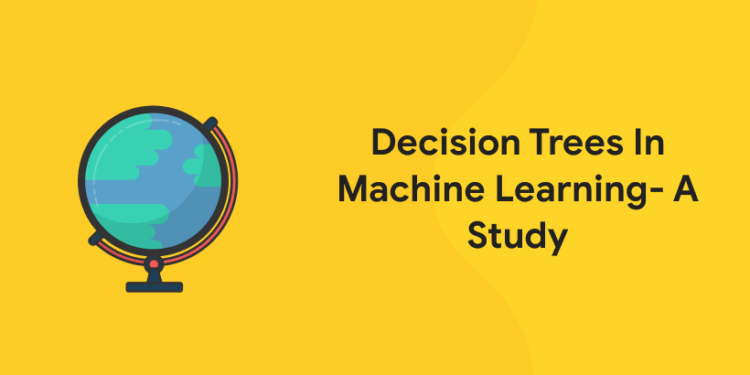Table of Contents
A tree has many analogies in real life, and turns out that it has influenced a wide area of machine learning, covering both classification and regression. In decision analysis, a decision tree can be used to visually and explicitly represent decisions and decision making. As the name goes, it uses a tree-like model of decisions. Though a commonly used tool in data mining for deriving a strategy to reach a particular goal, its also widely used in machine learning, which will be the main focus of this article.
Decision Tree Terminologies
Root Node: Root node is from where the decision tree starts. It represents the entire dataset, which further gets divided into two or more homogeneous sets.
Leaf Node: Leaf nodes are the final output node, and the tree cannot be segregated further after getting a leaf node.
Splitting: Splitting is the process of dividing the decision node/root node into sub-nodes according to the given conditions.
Branch/Sub Tree: A tree formed by splitting the tree.
Pruning: Pruning is the process of removing the unwanted branches from the tree.
Parent/Child node: The root node of the tree is called the parent node, and other nodes are called the child nodes.
Click here enroll in machine learning course in Entri app
How does the Decision Tree algorithm Work?
1: Who was the first woman President of India?
In a decision tree, for predicting the class of the given dataset, the algorithm starts from the root node of the tree. This algorithm compares the values of root attribute with the record (real dataset) attribute and, based on the comparison, follows the branch and jumps to the next node.
For the next node, the algorithm again compares the attribute value with the other sub-nodes and move further. It continues the process until it reaches the leaf node of the tree. The complete process can be better understood using the below algorithm:
- Step-1: Begin the tree with the root node, says S, which contains the complete dataset.
- Step-2: Find the best attribute in the dataset using Attribute Selection Measure (ASM).
- Step-3: Divide the S into subsets that contains possible values for the best attributes.
- Step-4: Generate the decision tree node, which contains the best attribute.
- Step-5: Recursively make new decision trees using the subsets of the dataset created in step -3. Continue this process until a stage is reached where you cannot further classify the nodes and called the final node as a leaf node.
Example: Suppose there is a candidate who has a job offer and wants to decide whether he should accept the offer or Not. So, to solve this problem, the decision tree starts with the root node (Salary attribute by ASM). The root node splits further into the next decision node (distance from the office) and one leaf node based on the corresponding labels. The next decision node further gets split into one decision node (Cab facility) and one leaf node. Finally, the decision node splits into two leaf nodes (Accepted offers and Declined offer). Consider the below diagram:
Free UPSKILLING Courses!
Take your first step toward mastering in-demand skills, acing interviews, and securing top-tier jobs with Entri's free upskilling courses.
Start Learning!How can an algorithm be represented as a tree?
For this let’s consider a very basic example that uses titanic data set for predicting whether a passenger will survive or not. Below model uses 3 features/attributes/columns from the data set, namely sex, age and sibsp (number of spouses or children along).
A decision tree is drawn upside down with its root at the top. In the image on the left, the bold text in black represents a condition/internal node, based on which the tree splits into branches/ edges. The end of the branch that doesn’t split anymore is the decision/leaf, in this case, whether the passenger died or survived, represented as red and green text respectively.
Although, a real dataset will have a lot more features and this will just be a branch in a much bigger tree, but you can’t ignore the simplicity of this algorithm. The feature importance is clear and relations can be viewed easily. This methodology is more commonly known as learning decision tree from data and above tree is called Classification tree as the target is to classify passenger as survived or died. Regression trees are represented in the same manner, just they predict continuous values like price of a house.
Attribute Selection Measures
While implementing a Decision tree, the main issue arises that how to select the best attribute for the root node and for sub-nodes. So, to solve such problems there is a technique which is called as Attribute selection measure or ASM. By this measurement, we can easily select the best attribute for the nodes of the tree. There are two popular techniques for ASM, which are:
- Information Gain
- Gini Index
Information Gain
- Information gain is the measurement of changes in entropy after the segmentation of a dataset based on an attribute.
- It calculates how much information a feature provides us about a class.
- According to the value of information gain, we split the node and build the decision tree.
- A decision tree algorithm always tries to maximize the value of information gain, and a node/attribute having the highest information gain is split first. It can be calculated using the below formula:
- Information Gain= Entropy(S)- [(Weighted Avg) *Entropy(each feature)
Entropy: Entropy is a metric to measure the impurity in a given attribute. It specifies randomness in data. Entropy can be calculated as:
Entropy(s)= -P(yes)log2 P(yes)- P(no) log2 P(no)
Where,
- S= Total number of samples
- P(yes)= probability of yes
- P(no)= probability of no
Gini Index
- Gini index is a measure of impurity or purity used while creating a decision tree in the CART(Classification and Regression Tree) algorithm.
- An attribute with the low Gini index should be preferred as compared to the high Gini index.
- It only creates binary splits, and the CART algorithm uses the Gini index to create binary splits.
- Gini index can be calculated using the below formula:
Gini Index= 1- ∑jPj2
Pruning: Getting an Optimal Decision tree
Pruning is a process of deleting the unnecessary nodes from a tree in order to get the optimal decision tree.
A too-large tree increases the risk of overfitting, and a small tree may not capture all the important features of the dataset. Therefore, a technique that decreases the size of the learning tree without reducing accuracy is known as Pruning. There are mainly two types of tree pruning technology used:
- Cost Complexity Pruning
- Reduced Error Pruning.
Free UPSKILLING Courses!
Take your first step toward mastering in-demand skills, acing interviews, and securing top-tier jobs with Entri's free upskilling courses.
Start Learning!Advantages of the Decision Tree
- It is simple to understand as it follows the same process which a human follow while making any decision in real-life.
- It can be very useful for solving decision-related problems.
- It helps to think about all the possible outcomes for a problem.
- There is less requirement of data cleaning compared to other algorithms.
Disadvantages of the Decision Tree
- The decision tree contains lots of layers, which makes it complex.
- It may have an overfitting issue, which can be resolved using the Random Forest algorithm.
- For more class labels, the computational complexity of the decision tree may increase.
Click here enroll in machine learning course in Entri app
Why is it important to choose Entri?
- Excellent online platform for all the Competitive Exams.
- Provides updated materials created by the Entri Experts.
- Entri provides a best platform with full- length mock tests including previous year question papers.
- You can download the app for free and join the required classes.
- Entri wishes you all the best for your examinations and future endeavours.
“YOU DON’T HAVE TO BE GREAT TO START, BUT YOU HAVE TO START TO BE GREAT.”











